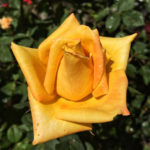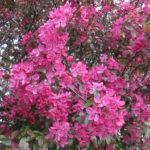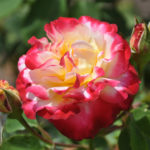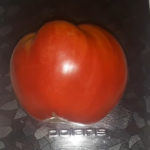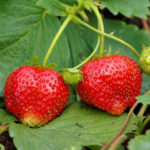Rose Summer Song
What should summer be like? Of course, colorful and bright. Such as the shining colors of the novelty from David Austin, which bears the very poetic name of Summer Song, or Summer Song. This cheerful flower belongs to the English roses, which, despite their unprecedented popularity and exquisite beauty, still stand alone in the group of shrub roses. The beautiful Ostinka attracted flower growers not only with abundant flowering and exquisite aroma, the hearts of rose growers were conquered by the unusual and cheerful color of the culture.
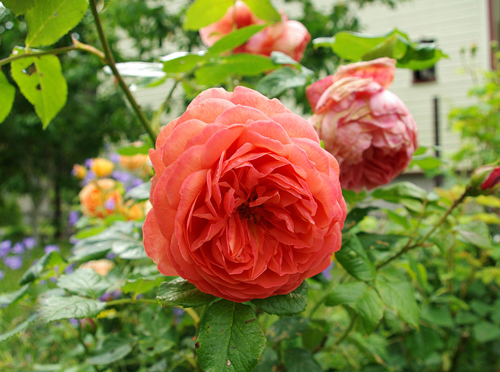
History of creation
Bright Summer Song belongs to the English selection. She appeared in the family nursery David Austin Roses Limited. Its author is David Austin, a great master who gave a second life to old roses. Date of presentation of new items in the UK - 2005 Name used for exhibitions - Summer Song. The registration name includes a unique alphabetic code that identifies the manufacturer and sounds like AUStango. The culture is patented in Australia, USA and New Zealand. Unfortunately, the manufacturer does not indicate which varieties were used to create this magnificent Englishwoman.
Description
Our heroine belongs to scrubs, that is, abundantly flowering shrubs. The plant forms an erect bush with a height of 100 - 120 cm. The crown is branched, fluffy, but the bottom of the perennial is often bare, which is not very popular with some growers. In the process of growth, the bush acquires a slightly spreading shape, but, as a rule, its width does not exceed 90 cm. The shoots are straight, strong and at the same time flexible. According to reviews, in the middle of summer, the perky heroine of our story can play naughty, releasing long, not too decorative shoots that need to be removed in time. The thorns are large, colored, and not numerous. The foliage is good. The leaves are medium in size, dark green, with a semi-glossy surface, they look very decorative. Each shoot is crowned with an elegantly drooping inflorescence of 3 - 5 gorgeous large flowers. Heavy brushes often bend strong shoots, but the bush does not lose its decorative effect.
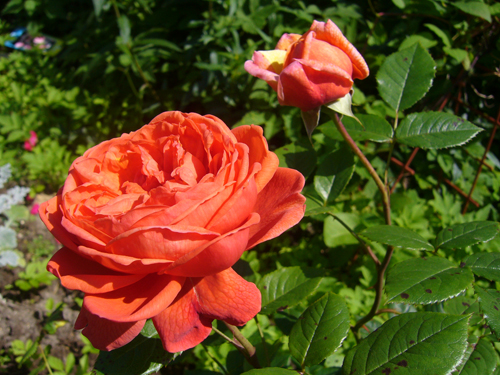
The buds are dense, rounded. The extraordinary charm and sophistication of the old rose is given to our heroine by the amazing spherical shape of the flower. The large outer petals are tightly and neatly packed into a kind of deep bowl, the inner part of which consists of smaller, randomly spaced petals. As they dissolve, the outer petals begin to bend back, and now we have a flower that looks like a lush rosette in front of us. During the period of complete dissolution, a bright yellow center is barely visible. The colors are chic, and although they are monochromatic, they cannot be described in one word. David Austin noted that a brilliant orange color is most suitable for describing complex coloration. In the process of flowering, the color range can change to bright orange, acquire warm copper shades. Some rose growers compare the color to tanned tangerine or red orange. In addition, the exclusivity of the variety is complemented by a dense double flower, which consists of more than 41 petals (according to some reports, there are 80 petals). The rosette is quite large, with a diameter of 10 to 12 cm.
Flowering period
Playful ostinka belongs to the re-flowering varieties of roses. Summer Song blooms with tides throughout the season and practically without interruption. Flowering begins early - in May, and ends quite late, around October or November, with the arrival of persistent cold weather. As rose growers note, a healthy shrub is abundantly covered with flowers, fresh buds come to replace the fading ones. The decorativeness of the flower does not last as long as we would like. Depending on the conditions, the rosette retains its freshness and elasticity from 3 days to a week. And then the petals lose their turgor and, according to the description, become "like rags."

To maintain the aesthetics of the perennial at a high level, faded sockets should be removed in time.The color lasts for a rather long time, does not fade, only before crumbling, the petals brighten noticeably, acquire a pinkish tint. The scent of Summer Song is strong, but pleasant and exquisite. As determined by a nursery expert, the scent resembles that of a flower shop, with hints of chrysanthemum leaves, ripe bananas and tea. However, despite all the complexity, many rose growers like the smell.
Characteristics
- Like most varieties of roses, Summer Song is capable of wintering without freezing at temperatures of minus 23.3 ° C, which corresponds to the 6th USDA zone. In cooler regions, the culture must be covered for the winter. If, nevertheless, the freezing of the bush happened, then it is able to recover quite quickly. Some sources reduce the degree of frost resistance to minus 20.6 ° C;
- the declared immunity is quite high. Our heroine has good resistance to black spot and powdery mildew. But, as some growers note, seedlings and weak plants often suffer from black spot;
- rain resistance is average. The opened flower can survive the rainy period, but it picks up water strongly, becomes heavy and bends the shoot even more. Therefore, after rain, it is better to lightly shake the outlet to remove excess moisture. The bud tolerates a wet period worse, it can rot from moisture and not open;
- the culture withstands the bright sun of central Russia, the color fades out. But the scorching rays of the southern sun can cause the flower rosette to fade too quickly.

Agrotechnics
In central Russia, autumn - late September or early October is considered a favorable period for planting the Summer Song rose. But the procedure can be carried out in the spring (from mid-April to the second half of May), so that during the growing season the culture has time to adapt in a new place and get stronger for the coming winter. A bright Englishwoman will do well in a well-lit place, protected from strong winds. True, in the south, partial shade is more suitable for Ostinka in the midday heat; the morning and evening sun will be quite enough for a flower. Highly nutritious and drained soils are preferred. If the soil on the site is heavy, containing a large amount of clay, dig a larger planting hole and fill it with a suitable soil mixture. Watering is carried out as needed, it is recommended to moisturize in the evening. One bush will require at least 5 liters of water. After watering, when the soil is slightly dry, loosening is carried out, breaking the dense soil crust and restoring gas exchange in the roots. They are fed at least 3 times a season, mainly with universal fertilizers. The first pruning is carried out in the spring, before the leaves begin to bloom. Then, in the summer, they pinch the tops of young shoots so that the bush is more magnificent. In the fall, faded buds, dried branches, weak shoots are removed. For the winter, the root zone is insulated with mulch; in cool regions, shelters are erected above the bush.
Rose Summer Song, due to its color, is rightfully considered the most unusual in the Ostink collection. Its bright color will revive any unsightly corner of the garden, fill it with radiance and optimism. But it is not easy to find a suitable neighbor for our heroine. The most successfully combined are yellow and apricot varieties of roses. But the safest option is to plant Summer Song against the background of low conifers, such as juniper. The variety is also very good in monochrome landings. A small nuisance in the form of exposing the lower part of the bush can be corrected by planting low pink varieties, a flower mixture of a suitable shade, hosts or perennial ground covers at the feet of our heroine. In care, the variety is not too picky. When planting, you need to take into account that the Englishwoman does not like the scorching sun and strong winds, she will require preventive treatments for diseases and pests.For attention and care, the rose will thank you with a long flowering period, charge you with positive and good mood.
